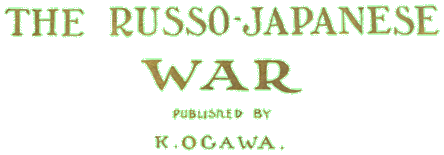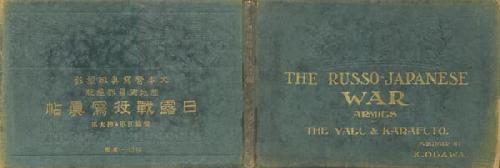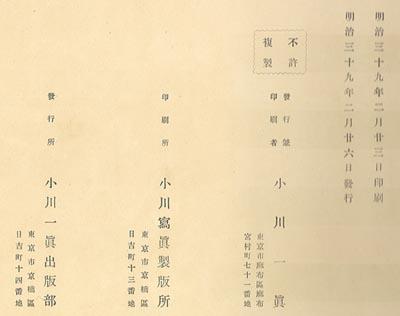|
~~ Armies of the Yalu and Karafuto ~~ |
||||||||||||||||||||||||
|
Index for Russo Japan War, 6 Volume Set |
||
| Naval | Yalu & Karafuto Armies | First Army |
| Second Army | Third Army | Fourth Army |
|
|
||
| Covers | Colophons | Statistics |
|
|
||
|
Return to the K. Ogawa Main Page
For information on a similar 2 volume set, Click here. |
||
|
|
||

The Russo-Japanese War:
Taken by the Photographic Department
of the Imperial Headquarters
Armies of the Yalu and Karafuto
Published by Kazumasa Ogawa, 1906
Part of a Six Volume Set

Armies of the Yalu and Karafuto Volume
Ogawa, K. (Kazumasa) (Publisher)
The Russo-Japanese War: Taken by the Photographic Department of the Imperial Headquarters, Armies of the Yalu and Krafuto, Tokyo, ©1904 by the Military Survey Department and published and printed by K. Ogawa, distributed by K. Ogawa, Tokyo and Kelly Walsh, Yohohama, Shanghai, Hongkong and Singapore, 1906, large oblong 4to (14 3/4 x 10 in - 37.5 x 25.5 cm), green blind stamped covers with gilt titles (boards and spine), listing of plates ("contents")
Part 1. "Operation of the Army of Yalu (The Battle of Mukden)," 12 pages of text in English and 11 pages of Japanese text plus 43 numbered pages of photographs and 10 unnumbered photograph plates. Part 2. "Karafuto (Saghalien) Expedition)," 3 pages of text in English and 3 pages of Japanese text plus 56 numbered pages of photographs.
All plates are black and white halftone photographs. Each plate has an English caption and Japanese descriptive captions and notes.
Major Sections of the Engish Text Portion.
-
Part 1.
- Operation of the Army of Yalu (the Battle of Mukden), Feb 1905
Part 2.
- Karafuto (Saghalien) Expedition, Jul- Sep 1905
For information on Kazumasa Ogawa, click here.
Complete Set of 6 VolumesThe Russo-Japanese War: A six volume set with continuing titles that read:
A matching set of 6 volumes, printed and distributed in 1905-6, large oblong 4to (14 3/4 x 10 in - 37.5 x 25.5 cm), green blind stamped covers with gilt titles (boards and spine), Tokyo, Naval volume copyrighted by T. Ichioka, 1904, Army volumes copyrighted by the Military Survey Department, 1904. An extensive photographic survey of the War dedicated to the First to Fourth Armies, the Armies of the Yalu and the Karfoto, and the Navy. The plates, which have descriptive captions, are supplemented by text pages (in English and Japanese) which reflect official Japanese military reports regarding the operations of the Navy and Armies in the Russo-Japanese War. The text accounts run in chronological order and recount the significant battles, operations and activities. In total the set contains 856 black and white halftone plates (736 - Army & 120 - Navy) produced by K. Ogawa, 136 pages of text in English, 123 pages of text in Japanese. Of the 856 plates, 11 plates fold-out and 14 plates have tissue overlays with descriptive information in Japanese. There is one loose map with the set. All 6 books have the same basic format. When read Western style, from front to back, the front cover is in English. It is followed (all in English) by the title page, the "Imperial Proclamation of War," text pages and finally a listing of plates. The English section ends next to last plate in the book. When read Japanese style, from back to front, the cover is in Japanese. It is followed (all in Japanese) by a title page, portrait plate(s) of Imperial family members in the military and key military members, the "Imperial Proclamation of War," text pages, a listing of plates in Japanese, and the plates with the last plate adjoining the end of the English portion of the book. All plates have descriptive captions in Japanese above the image and in English below the image. Plates in the Army books are numbered and there are plates (plates right after the title page) not included in the numbers. The plates are generally, but not always, printed back to back. The image area is approximately 7 x 10 in. The Army books share common plates (generally 10). These plates relate to the "Triumphal Return" of the Armies in Manchuria (8 plates at the back of the numbered plates) or they are portraits of commanders (2 plates at the front of the book). It is clear that the books were edited to not present images of horrors of war. I find very few plates that show the actual human carnage or death on the battlefield. In general the images show battles in progress, important locations, key terrain, key figures (both Japanese and enemy), captured ordnance and munitions, troops in combat and at rest, prisoners of war, first aid stations and hospitals, ships and military equipment and an occasional dead horse.
|
Illustrations in this Volume
(All Black & White Halftone Images)
Title Pages (English and Japanese)
Same on all Army Volumes except for the Army Number
Part 1. Operation of the Army of Yalu (the Battle of Mukden) [No Royal Family Portrait as in Other 4 Army Volumes] Calligraphic Title Page (same in all 5 Army volumes)
Below 2 plates in all 5 Army volumes --- Portraits (Field Marshal Marquis Yamagata & Major General Nakaoka)
--- Portraits (Field Marshal Marquis Oyama & General Baron Kodama)
The Staff of the Army Headquarters at Fushun (1) A distant view of Fushun and a Russian defence position in its neighbourhood. {2) A view of Yingp'an across the Hun River from Saerhhucheng. (3) A Russian artillery position north of Imensai. (4) A hastily-built bridge over the Hun River on the southern edge of Huangshalutzu. (5) Division Commander Sameshima delivering an address. (6) A Russian defence position on the northeastern edge of Fushun. (7) Remains of Russian provision stores after a fire at Maniulutzu. No. 1. (8) Remains of Russian provision stores after a fire at Maniulutzu. No. 2. (9) Part of a Russian defence position north of Fushun. (10) A Russian observation post north of Fushun. (11) The South Gate of Fushun.
(12) The Castle-Wall of Fushun. (13) Asalaira Hill, the scene of a desperate fight by the Forty-fourth Infantry Regiment. (14) A light railway for purposes of transportation between Fushun and Sanlungyu. (15) A Russian military bridge over the Hun River south of Fushun. (16) Delivery of the Imperial Message by Lieutenant-colonel Ito, aide-de-camp to His Majesty. (17) Army Headquarters at Sanlungyu. (18) A Russian shell exploding on a hill south-west of Wupainiulu and a view of the Temporary Dressing Station of the Twelfth Infantry Regiment. (19) Cannonading of the Russians in the direction of the Chiupingt'ai from a point about 3000 metres north of Sanlungyu, (20) Patients being brought to the Third Hospital of the Eleventh Division at Sanlungyu. (21) The Commander of the Army watching a battle from a hill about 3000 metres north of Sanlungyu. (22) Mach'untan in flames. (23) Fushun-cheng at the time of its capture. (24) Dead and wounded horses on the bank of the Hun River south of Fushun-cheng. (25) Collection of small-arms seized at Fushun. (26) Collection of shells seized at Fushun. (27) A view of Fushun-cheng from the foot of the Kaoshan Tower near Fushun.
(28) A hill north of Fushun, the Kaoshan Tower and Russian covered trenches. (29) A view, from Russian siege-trenches at the foot of the Kaoshan Tower, of a Russian defence position on a hill to the northeast. (30) A view, from a Russian position on a hill north of Fushun, of a position to the west in the direction of the Kaoshan Tower. (31) A Russian defence position on a hill northeast of Ts'angshih. (32) A Japanese position on a hill north-east of Ts'angshih. (33) Fording of the Hun River between Erhhuolao and Ts'angshih, (34) A waggon park behind the artillery and engineers departments of the Army. (35) A view from Kawamura Park on the riding ground and Yung-linghsipu. (36) A view from Hsiayuan village of the River Sutzuu and an edge of Hsinglungchieh. (37) A general view of the Mausoleum of the Founder of the Manchu Dynasty. (38) The Front Gate of the above-mentioned Mausoleum. (39) Portion of the four monument building of the Mausoleum. (40) The Inner Sanctuary of the Mausoleum. (41) The entrance to the service ground at the festival. (42) A general view of the service ground at the festival. (43) The hexagonal building at the Kinluan Palace in Mukden.
---- Marshal Marquis Yamagata Being Welcomed at Mukden
---- Marshal Marquis Oyama, Commander-in-Chief of the Japanese Armies in Manchuria, and His Staff
---- Major-General Fukushima, The Japanese Commissioner for Arranging an Armistice, on His Way to the Meeting-Place of Commissioners
---- The Meeting of the Commissioners Appointed to Arrange Armistice
---- Triumphal Return of General Headquarters Staff of the Japanese Armies in Manchuria. No 1.
---- Triumphal Return of General Headquarters Staff of the Japanese Armies in Manchuria. No 2.
---- Triumphal Return of General Headquarters Staff of the Japanese Armies in Manchuria. No 3.
---- Triumphal Return of General Headquarters Staff of the Japanese Armies in Manchuria. No 4.
Part 2. Karafuto (Saghalien) Expedition (1) A Division Commander and his staff. (2) Part of the Fifteenth Regiment landing near Mereya. (3) A Japanese gun-boat covering the landing of the Naval Brigade. (4) The Brigade Headquarters, the Second Anchorage Headquarters, and the Naval Land-communication Department at the landing-place near Mereya.
(5) The Forty-ninth and Fiftieth Infantry Regiments landing near Mereya. (6) Part of the Fiftieth Infantry Regiment at the village of Mereya. (7) Part of the village of Savinapadi. (8) The north-western portion of the village of Savinapadi. (9) The Advance of the Forty-ninth Infantry Regiment as seen from a hill on the western edge of the village of Savinapadi. (10) Some of the refugees of Karafuto.
(11) A general view of the village of Poroantmari. (12) The stores of the Japanese Naval Brigade being landed on the coast at Poroantmari, (13) Part of the Russian defence on a hill on the coast near Korsakovsk. No. 1. (14) The view of the pier of Korsakovsk. (15) A labourer's family at Poroantmari. [16} Part of the Russian defence on a hill on the coast near Korsakovsk. No. 2. (17) Herring being dried at the village of Ichiya. (18) Part of the Nineteenth Field Artillery Regiment marching into the village of Mitriyofka. (19) A great wood between Mitriyofka and Listovenidhnaya. (20) Baggage train advancing on the road through the village of Mitriyofka. (21) Part of the Thirteenth Engineers Battalion encamped at Lislovenichnaya.
(22) Part of Vladimirofka. No. 1. (23) Barracks under construction at Vladimirofka. (24) Part of Vladimirofka. No. 2. (25) A volunteer corps which surrendered at Vladimirofka. (26) Position of the Third Battery of the Nineteenth Field Artillery Regiment near the village of Dalineye. (27) Position of the Fourth Battery of the Nineteenth Field Artillery Regiment in a pasture on the north-western edgeof the village of Dalineye. (28) The First Battalion of the Nineteenth Field Artillery Regiment resting from a march through muddy roads after rain. (29) A Russian field gun abandoned near the village of Dalineye. (30) The Brigade Commander and some of his subordinates at Vladimirofka. (31) Staff of the Headquarters of the Independent Thirteenth Division at Luikoff. (32) Staff of the Etape Inspection Department of the Independent Thirteenth Division at Alexandrovsk.
(33) Landing at First Alkova on the 25th July. (34) Cannonade of First Alkova by Japanese Warships. (35) Burning of the village of First Alkova. (36) The pier at Alexandrovsk. (37) Landing of nurses from the hospital ship "Kohina."
(38) A distant view of the lighthouse on Cape Jonquieres. (39) A church in the town of Alexandrovsk. (40) A colliery near Due. (41) A road over Pilyonsky Hill. (42) Gun-carriages being conveyed up the road over Pilyonsky Hill. (43) A easterly view of the road over Pilyonsky Hill. (44) A view of the village of Werfnyarm-dan. (45) A north-westerly view from the centre of the village of LuikofF. (46) The meeting of the Parlementaires at the Luikofd Church. No. 1. (47) Prisoners of war being examined in the barracks at Luikoff. (48) The meeting of the Parlementrires at the Luikoff Church. No. 2. (49) A Russian field gun found abandoned at the village of Tauran. (50) The encampment-ground at the village of Dardagan as it appeared prior to the departure of the troops. (51) The Chief Commissioner, together with his party, for negotiating the surrender of the Russians at First Hamdasa on the 3ist July. (52) The meeting of the Japanese and Russian Commissioners at Hamdasa on the 31st July.
(53) Part of the town of Alexandrovsk. (54) The Staff in charge of the Second Anchorage-ground on the Pier at Alexandrovsk. (55) Prisoners of war in the town of Alexandrovsk. (56) A south-easterly view from a hill lying to the north-west of the town of Alexandrovsk.
Dating the book.

The two rows of characters at the far right indicate the following (going from the right row to the left).
- Meiji 39 (1906), February 23 - Printed
- Meiji 39 (1906), February 26 - Distributed
|
Index for Russo Japan War, 6 Volume Set |
||
| Naval | Yalu & Karafuto Armies | First Army |
| Second Army | Third Army | Fourth Army |
|
|
||
| Covers | Colophons | Statistics |
|
|
||
|
Return to the K. Ogawa Main Page
For information on a similar 2 volume set, Click here. |
||
|
|
||